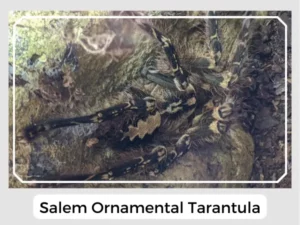The Salem ornamental tarantula is a special kind of spider from southern India. People in the U.S. often keep them as pets. Here, we’ll share interesting facts about this tarantula for you.

Photo Credit: Victoria E.
The female mother lays her eggs inside a sac made of webbing.
When they are young, they tend to hide and dig their own burrows in their environment. They become mature at around 2 years.
Contrary to many other tarantula species, the Salem Ornamental Tarantula does not rely on webs to capture its prey. Instead, they employ an ambush strategy, using their agility and venom to subdue their meals.
Yes, Salem Ornamental Tarantulas are venomous, like all tarantulas. They use their venom to catch prey.
Yes, these tarantulas possess very potent venom, with their bite even leading to hospitalizations. However, there haven’t been any recorded deaths so far.
In their natural habitat, the Salem Ornamental Tarantula plays a vital role in maintaining the balance of the ecosystem. As predators, they help control the population of insects and other small creatures, contributing to the overall health of the tropical forests they inhabit. Their nocturnal and ambush predation behaviors add an intriguing layer to the biodiversity of their environment, showcasing the complexity of nature’s interactions.
Natural Predator and Prey-Predator Dynamics: Despite their formidable appearance and venomous bite, Salem Ornamental Tarantulas are not without their own natural predators. Larger animals and birds often prey on these spiders, creating a delicate balance within the ecosystem.
Relationship with Humans: In recent years, the Salem Ornamental Tarantula has found a place in the hearts of arachnid enthusiasts, becoming a popular choice for a pet. Their striking appearance and intriguing behavior make them a fascinating addition to any collection. However, it is essential for potential owners to be aware of their venom potency and the responsibilities that come with keeping such a creature.
| Other names | Beautiful parachute spider, Finely formed parachute spider |
| Lifespan | Male: 3-4 years Female: 12-15 years |
| Distribution | Southern India, between Salem and Tirupathi in the Eastern Ghats |
| Habitat | Tropical forests |
| Diet | Butter worms, cockroaches, crickets, houseflies, locusts, mealworms, and superworms |
In wrapping, the Salem Ornamental Tarantula stands as a testament to the beauty and complexity of arachnids.
The Salem ornamental tarantula is a special kind of spider from southern India. People in the U.S. often keep them as pets. Here, we’ll share interesting facts about this tarantula for you.

Photo Credit: Victoria E.
The female mother lays her eggs inside a sac made of webbing.
When they are young, they tend to hide and dig their own burrows in their environment. They become mature at around 2 years.
Contrary to many other tarantula species, the Salem Ornamental Tarantula does not rely on webs to capture its prey. Instead, they employ an ambush strategy, using their agility and venom to subdue their meals.
Yes, Salem Ornamental Tarantulas are venomous, like all tarantulas. They use their venom to catch prey.
Yes, these tarantulas possess very potent venom, with their bite even leading to hospitalizations. However, there haven’t been any recorded deaths so far.
In their natural habitat, the Salem Ornamental Tarantula plays a vital role in maintaining the balance of the ecosystem. As predators, they help control the population of insects and other small creatures, contributing to the overall health of the tropical forests they inhabit. Their nocturnal and ambush predation behaviors add an intriguing layer to the biodiversity of their environment, showcasing the complexity of nature’s interactions.
Natural Predator and Prey-Predator Dynamics: Despite their formidable appearance and venomous bite, Salem Ornamental Tarantulas are not without their own natural predators. Larger animals and birds often prey on these spiders, creating a delicate balance within the ecosystem.
Relationship with Humans: In recent years, the Salem Ornamental Tarantula has found a place in the hearts of arachnid enthusiasts, becoming a popular choice for a pet. Their striking appearance and intriguing behavior make them a fascinating addition to any collection. However, it is essential for potential owners to be aware of their venom potency and the responsibilities that come with keeping such a creature.
| Other names | Beautiful parachute spider, Finely formed parachute spider |
| Lifespan | Male: 3-4 years Female: 12-15 years |
| Distribution | Southern India, between Salem and Tirupathi in the Eastern Ghats |
| Habitat | Tropical forests |
| Diet | Butter worms, cockroaches, crickets, houseflies, locusts, mealworms, and superworms |
In wrapping, the Salem Ornamental Tarantula stands as a testament to the beauty and complexity of arachnids.